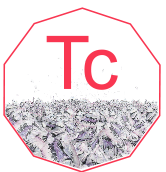Technetium

Technetium (Tc)
General Information
- Symbol: Tc
- Atomic Number: 43
- Atomic Weight: [98] (most stable isotope, Technetium-98)
- Element Category: Transition metal
- Group: 7
- Period: 5
- Block: d-block
Physical Properties
- Appearance: Silvery-gray metallic
- Density: 11.5 g/cm³
- Melting Point: 2157 °C (3915 °F)
- Boiling Point: 4265 °C (7709 °F)
- Phase at STP: Solid
- Electron Configuration: [Kr] 4d⁵ 5s²
- Oxidation States: +7, +6, +5, +4 (most common), +3, +2, +1
Chemical Properties
- Reactivity: Reacts with oxygen and acids, forms various oxides and halides.
- Compounds: Forms compounds such as technetium dioxide (TcO₂), technetium tetrachloride (TcCl₄), and sodium pertechnetate (NaTcO₄).
Uses and Applications
- Medical Imaging: Technetium-99m is widely used in diagnostic nuclear medicine, particularly in imaging and functional studies of organs.
- Industry: Used as a corrosion inhibitor in steel.
- Research: Used in various scientific research applications due to its unique properties.
Occurrence and Extraction
- Natural Occurrence: Technetium is not found naturally in the Earth’s crust due to its radioactivity and short half-life; it is produced synthetically.
- Extraction: Produced in nuclear reactors as a fission product of uranium-235.
Isotopes
- Stable Isotopes: Technetium has no stable isotopes.
- Radioactive Isotopes: Technetium-98 (most stable, half-life of 4.2 million years), Technetium-99 (half-life of 211,000 years), Technetium-99m (metastable, half-life of 6 hours, used in medical imaging).
Safety and Handling
- Hazards: Radioactive, requires careful handling and storage to avoid radiation exposure.
- Precautions: Use protective equipment and follow safety protocols when handling technetium compounds, especially in medical and industrial settings.
History
- Discovery: Discovered by Carlo Perrier and Emilio Segrè in 1937.
- Name Origin: Named from the Greek word “technetos,” meaning artificial, since it was the first element to be produced artificially.
Additional Facts
- Crystal Structure: Hexagonal close-packed (hcp)
- Magnetic Properties: Paramagnetic
- Thermal Conductivity: Moderate, about 50.6 W/m·K
- Electrical Resistivity: About 200 nΩ·m at room temperature
Summary
Technetium is a transition metal known for its unique position as the first artificially produced element. It has significant applications in medical imaging, particularly Technetium-99m, which is essential in nuclear medicine. Technetium’s radioactive nature requires careful handling, and it is primarily produced in nuclear reactors. Its various isotopes have different half-lives and applications in both medical and industrial fields.
What is the atomic number of Technetium?
- 43
What is the symbol for Technetium?
- Tc
What is the atomic weight of Technetium?
- [98] (most stable isotope, Technetium-98)
In which group of the periodic table is Technetium found?
- Group 7
What period is Technetium in?
- Period 5
What block does Technetium belong to?
- d-block
What is the melting point of Technetium?
- 2157 °C (3915 °F)
What is the boiling point of Technetium?
- 4265 °C (7709 °F)
What is the density of Technetium?
- 11.5 g/cm³
What is the electron configuration of Technetium?
- [Kr] 4d⁵ 5s²
What are the common oxidation states of Technetium?
- +7, +6, +5, +4 (most common), +3, +2, +1
What is the appearance of Technetium?
- Silvery-gray metallic
Is Technetium reactive with oxygen?
- Yes, it reacts with oxygen
Name a compound of Technetium.
- Technetium dioxide (TcO₂)
What is a common use of Technetium in medicine?
- Technetium-99m for diagnostic imaging
How is Technetium used in industry?
- As a corrosion inhibitor in steel
What role does Technetium play in research?
- Used in various scientific research applications
Is Technetium naturally occurring?
- No, it is produced synthetically
How is Technetium produced?
- In nuclear reactors as a fission product of uranium-235
What is the most stable isotope of Technetium?
- Technetium-98
Name a radioactive isotope of Technetium used in medical imaging.
- Technetium-99m
What safety hazard is associated with Technetium?
- Radioactive, requires careful handling
Who discovered Technetium?
- Carlo Perrier and Emilio Segrè
Where does the name Technetium come from?
- From the Greek word “technetos,” meaning artificial
What is the crystal structure of Technetium?
- Hexagonal close-packed (hcp)
Is Technetium paramagnetic or diamagnetic?
- Paramagnetic
What is the thermal conductivity of Technetium?
- About 50.6 W/m·K
What is the electrical resistivity of Technetium at room temperature?
- About 200 nΩ·m
What is the primary oxidation state of Technetium?
- +4
Is Technetium found as a free element in nature?
- No, it is produced synthetically
What is the common name of sodium pertechnetate?
- NaTcO₄
What is a major application of Technetium tetrachloride (TcCl₄)?
- Used in research and industrial processes
How does Technetium inhibit corrosion?
- By forming a protective layer on steel surfaces
What is the boiling point of Technetium in Kelvin?
- 4540 K
What group does Technetium belong to in the periodic table?
- Transition metals
What is the half-life of Technetium-99m?
- 6 hours
Can Technetium be used in high-temperature applications?
- Yes, due to its high melting point
What makes Technetium valuable in medical imaging?
- Its radioisotope, Technetium-99m, provides clear images and has a short half-life
What is the natural abundance of Technetium isotopes?
- Technetium has no naturally occurring stable isotopes
What is the key property that makes Technetium valuable in steel?
- Its ability to inhibit corrosion.






